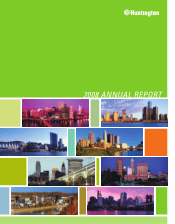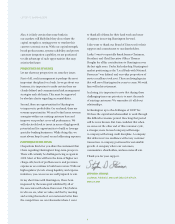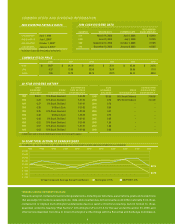Huntington National Bank 2008 Annual Report Download - page 4
Download and view the complete annual report
Please find page 4 of the 2008 Huntington National Bank annual report below. You can navigate through the pages in the report by either clicking on the pages listed below, or by using the keyword search tool below to find specific information within the annual report.
Huntington’s performance was obviously impacted
negatively by this environment. Yet, in some ways
we fared better than most. Our loss of $113.8 million
for the year, or $0.44 per common share, was far less
on a relative basis than that of most of our peers.
Revenues increased more than expenses. But this
positive difference was more than offset by the $413.8
million, or 64%, increase in provision for credit loss
expense needed to strengthen our allowance for credit
losses. Our allowance for credit losses increased from
1.61% of total loans and leases at the end of 2007
to 2.30% at the end of last year. This level of provision
expense enabled us to substantially address our
relationship with Franklin Credit Management.
We are now positioned with the flexibility to pursue
opportunities to unlock the value of Franklin’s
servicing platform for the benefit of our shareholders.
The provision also reflected higher net charge-offs
in our non-Franklin-related loan portfolio, driven
by the deteriorating economy.
Reflecting this difficult environment and credit-
driven earnings pressure, as well as heightened
industry concerns, our stock price declined 48% for
the year. This was comparable to the median decline
in our peer bank group. And the pressure on capital
that came from declining earnings power and the
ultimate full-year loss resulted in two reductions
in our quarterly common stock dividend. The first
was a 50% reduction announced on April 15, 2008,
from a quarterly $0.265 per common share to $0.1325
per common share. The second was the reduction
announced on January 22, 2009, to $0.01 per common
share. These decisions were difficult but necessary
in these challenging times. We clearly recognize the
hardship this places on our shareholders. We believe
that it is essential to align management interests with
those of shareholders. In that regard, on February 3,
we announced an expense initiative that is expected
to reduce 2009 expenses by a net $100 million. This
includes several across-the-board actions impacting
compensation. Specifically, and among other actions,
no 2008 bonuses or incentive compensation will
be paid, nor will any 2009 merit increases be given.
In addition, compensation for the Board of Directors
going forward will now only be in the form of
common stock with no cash component.
Our regulatory capital position at year-end was
above the regulatory “well-capitalized” minimums,
even excluding the infusion of the $1.4 billion of
capital we received from participating in the U. S.
Treasury’s Troubled Asset Relief Program’s (TARP)
Capital Purchase Plan. This made capital even stronger.
Our Tier 1 risk-weighted capital ratio, the primary
regulatory measurement, was 10.72%, slightly ahead
of our peers and more than $2 billion greater than
the “well-capitalized” threshold. And we entered
2009 with ample liquidity to continue to meet the
needs of our customers.
The full detail of our financial performance is
discussed in the Management Discussion and Analysis
section found later in this report. Please take the
opportunity to read this. It provides additional insight
into our 2008 financial performance.
All of this might leave the impression that the future
offers little to our shareholders and customers. Nothing
could be more wrong. Underneath these storm clouds
is a very good franchise with committed and highly-
motivated associates. Their efforts, combined with your
continuing business, give us a bright future when the
economy rebounds. As Huntington’s new leader, I want
to devote the rest of this letter to outline certain beliefs.
RELATIONSHIPS MATTER
Throughout my banking career, I have found that
companies that focus on cultivating customer
relationships win. When you are positioned in the
market as the “local” bank, like Huntington, customer
loyalty for generations can occur. In these days of
impersonalized service, a bank that demonstrates
it truly cares about meeting the needs of its customers
creates a customer loyalty that the competition cannot
penetrate. That is Huntington. Associates can be proud
2
LETTER TO SHAREHOLDERS

















